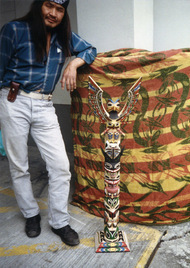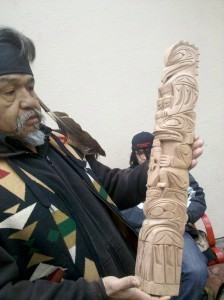Seattle Met feature story: The Carver's Life
While researching my biography of Robert "Believe It or Not" Ripley, I learned about Ripley's visit to Seattle in 1937, when he spent $1,000 at Ye Olde Curiosity Shop. Among his purchases were a couple totem poles by a Native American carver named Sam Williams. I later learned that John Williams, who was shot and killed by Seattle police last August, was Sam's grandson. This is the story of John and his family…
[Below is an excerpt. The full story can be found at Seattle Met magazine. A video of the shooting can be found here.]
The Carver's Life
The most gifted in a long line of Native American woodcarvers, John T. Williams made striking totem poles even while succumbing to drink and life on the streets. On the day of his violent death last August, he had vowed once more to turn his life around.
The shaky video, recorded by a Seattle police officer's dashboard camera, and later played over and over in a King County courtroom, tells the end of the story. It goes like this…
A police cruiser rolls to a stop on a cloudless summer afternoon as cars and pedestrians crisscross a downtown intersection. A long-haired man limps through the crosswalk, hunched over something in his hands, then disappears offscreen. The police cruiser lurches forward, stops again. A young officer named Ian Birk gets out, his pistol already in hand, and strides toward the limping man.
"Hey," Birk yells. "Hey… Hey!"
The video notes the day and time: -August 30, 4:12:30pm. "Put the knife down," shouts Birk, now moving out of the video camera's view and onto the sidewalk. "Put the knife down. Put the knife down!" Suddenly, at 4:12:35, less than five seconds after the first "Hey": POW-POW-POW-POW-POW! A pedestrian flinches.
Birk had been listening to sports radio, whose announcers suddenly start laughing, almost as if on cue. The cruiser's police radio intrudes: "Shots fired, Boren and Howell."
Witnesses would later describe what the video failed to capture: the strangely graceful pirouette of the victim, four hollow—point bullets in his body, falling slowly backwards; the two items in his hands clattering to the sidewalk beside his bleeding body. To his left, a scrap of wood. To his right, a single-blade pocketknife.

John Williams in his early 20s with one of his carvings.
The wood and the knife. They'd been John T. Williams's constant companions and among his only possessions for most of his 50 years. Throughout an abusive and violent boyhood and an equally difficult adulthood on the streets of Seattle, the pocketknife had become an extension of himself, its blade shaping two-by-two and four-by-four lengths of yellow cedar and sugar pine into the caricatured faces of bears, wolves, beavers, and ravens, works of art that sold for hundreds, sometimes thousands of dollars. The wood -Williams clutched in his calloused hand that August afternoon contained the preliminary etchings of an eagle, similar to the bald eagle spreading its wings upon his tattered cap, which read "Native Pride."
Anyone who's visited downtown Seattle has seen Williams or others like him, his street brothers and sisters, his real brothers and sisters. Though native peoples have been a downtown fixture since the city was named for one of their own, a conspiracy of factors—from limited formal education to discrimination to addiction woes—has condemned many to a hardscrabble lifestyle. Some gather daily beneath the totems in Pioneer Square or beside the fountains at Westlake Center. Some beg for change, clutching empty Starbucks cups, or peddle copies of Real Change newspapers outside storefronts. And some, like Williams, sit on the benches of "Indian Park," as some Native Americans call Victor Steinbrueck Park, near Pike Place Market, where they carve totem poles and wooden masks and plaques for tourists.
"What did you do?" shouts a passerby. "Did you shoot that man?"
Birk, frozen and apparently in shock, keeps his black Glock aimed at the prone and dying Indian.
"Ma'am, he had a knife and he wouldn't drop it," Birk says.
More officers arrive, and Birk begins to explain, "Yeah, he had the knife open." Another officer tells Birk he did a "good job."
But then police and witnesses notice: The knife's three-inch blade is closed.
Meanwhile, two of Williams's brothers sit waiting for him at Indian Park. John hadn't seen older brother Rick and younger brother Eric in months, but they'd all reunited two days earlier and they'd been carving together that morning, side by side on a park bench, just as they had since childhood. John started working on his eagle, then left around midday to get some beer. He had been shuffling along Howell Street that afternoon, back toward Rick and Eric, who continued to wait, still carving on the park bench, while a dozen blocks away police handcuffed their now dead brother.
If you have read about Williams's death, about the police department's admission that the shooting was unjustified, about Birk's resignation and the King County prosecutor's decision not to press charges against him, you'd be forgiven for thinking it was the sad, inevitable end to the hard life of a homeless Indian. But you'd be missing the rest of the story.
The story of John T. Williams is as tragic as you'd expect. Less expected is the story of a close-knit and loving family of talented artists whose history is entwined with Seattle's.
[To read the rest, visit Seattle Met]
Finally, here's a photo I took of John's brother, Rick, who cooperated with the story. He's been working (at Seattle Center) on a 32-foot memorial totem pole in his brother's honor. He's holding a replica of the memorial pole.

Rick Williams




